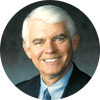On the other hand, the lifestyle and livelihood of the workers, the women awaiting the landing of another ship, the life in the ghettos of Paris, and the survivors of the revolution conjure the lyrics, "...nothing ever changes, nothing ever will..."
After 14 years at the helm of Southern California University of Health Sciences (formerly known as the Los Angeles College of Chiropractic - now there is a change!) I have heard the complaint that nothing ever changes. There is a certain truth to that statement, but at the same time, it is woefully inaccurate.
Today's mantra is, "The only constant is change." Yet, we cling to the past, we wrap ourselves around that with which we are familiar and grasp for certainty, all the time fearing the effects of change will be negative.
Change is real, and its relative value of being "good" or "bad" is grounded in our own perspective. When change provides new opportunities, growth or challenges, we may be moved from our comfort zone, but at the same time, we are exposed to the potential of creating a better comfort zone. After all, moving the cheese isn't all that bad. Everyone should be repotted from time to time.
In Les Miserables, those who changed found new perspectives in their lives, while those who failed to embrace change were doomed to perpetual existence in squalor and servitude.
The past 20 years have seen much change in chiropractic: The science has expanded; the educational programs have vastly improved; acceptance in society and government has exceeded expectations; the art has become more refined; and the philosophy has become part of the debate. While change has been troublesome for some, it has created new opportunities for others.
Chiropractic has certainly had its advocates against change. Huddled under the protective cover of a philosophical umbrella, change has been castigated as being "too medical" or "not true chiropractic." The positions taken and the arguments presented often fall prey to being anti-intellectual or anti-scientific. Would-be practitioners of a "supposed" scientific discipline end up portraying themselves as zealots of a pseudo-religious cult.
Fortunately, this profession rides on the backs of the majority in the middle - those who have found a balance between their belief systems (their basis for certainty) and the progress of knowledge and science (the basis of change). I salute the balance achieved between tradition and change. This has been our goal at LACC/SCUHS.
Twenty years ago, a struggling chiropractic program that was on the verge of extinction adopted a new model - a nonchiropractor as its new president. Under a different style of leadership, the swaying vessel (Glendale) was steadied, new moorings (in Whittier) were obtained, and the school began to thrive once more. Over the next decade, improvements were made to the new facility, faculty ranks were enhanced with new scholars, research became a central focus, and academic quality became center stage.
The decade of the '90s saw the introduction within the chiropractic profession of the first competency-based, problem-centered curriculum (1990), known as the Advantage Program. LACC became the first and remains the only chiropractic program to obtain WASC (regional institutional) accreditation in California. LACC was also one of the three chiropractic programs to first obtain federal research support.
Over the past 20 years, the leadership of LACC have played major roles in the Council on Chiropractic Education; the Council on Chiropractic Education International; Association of Chiropractic Colleges; American Chiropractic College of Radiology; American Chiropractic College of Orthopedics; ACA Council on Rehabilitation; the Department of Defense Demonstration Project; Chiropractic Advisory Committee to the Department of Veterans Affairs; Consortium for Chiropractic Research; California Chiropractic Association - and the list could continue.
LACC took a bold move at the turn of the century by developing its own master's degree program in acupuncture and Oriental medicine (CAOM). With two colleges on one campus, a broadening of the name led to the Southern California University of Health Sciences, home of LACC and CAOM, and a cross-pollenization of two parallel professions resulted.
To some, "nothing ever changes." To others, "change is the only constant." While we all ride on the same ship, Earth, we perceive and interpret our experiences differently. And while we all feel comfortable knowing "where our cheese is," we also need to be repotted so we can expand our roots, increase our upward movement and produce a larger number of flowering trees with sweet, savory fruit.
I look forward to the next 20 years, and to the many changes and challenges that await us.
Reed Phillips, DC, PhD
President, Southern California University of Health Sciences
Whittier, California
Click here for previous articles by Reed Phillips, DC, PhD.





